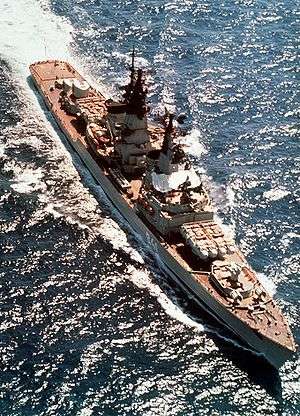Kynda-class cruiser
The Project 58 missile cruisers (Ракетные крейсера проекта 58), known to NATO as the Kynda class[1] and sometimes referred to as the Grozny class (тип «Грозный»), from the name of the first ship of the series to be constructed, were the first generation of Soviet missile cruisers and represented a considerable advance for the Soviet Navy. Their main role was anti-surface warfare using the SS-N-3b 'Shaddock' missile. The design proved to be top-heavy and was soon succeeded by the larger Kresta I class, but the Kyndas stayed in service until the fall of the Soviet Union.
 Kynda-class missile cruiser | |
| Class overview | |
|---|---|
| Name: | Kynda class |
| Builders: | Zhdanov, Leningrad |
| Operators: | |
| Preceded by: | Sverdlov class |
| Succeeded by: | Kresta I class |
| In service: | 1962 - 2002 |
| Planned: | 16 |
| Completed: | 4 |
| Cancelled: | 12 |
| Retired: | 4 |
| Preserved: | 0 |
| General characteristics | |
| Type: | Cruiser |
| Displacement: | 4,400 tons standard, 5,500 tons full load |
| Length: | 141.7 m (465 ft) - 141.9 m (466 ft) |
| Beam: | 15.8 m (52 ft) |
| Draught: | 5.3 m (17 ft) |
| Propulsion: |
|
| Speed: | 34 kn (63 km/h; 39 mph) |
| Range: |
|
| Complement: | 390 |
| Armament: | |
| Aviation facilities: | Helipad |
Design
The specifications (TTZ in Russian) for this class were issued in 1956.
The main armament comprised two trainable quadruple SS-N-3 anti shipping missile mountings; one forward one aft. One set of reload missiles was carried (16 missiles in total). Defensive armament comprised a twin SA-N-1 missile launcher forward and two twin 76mm guns aft. Two RBU-6000 anti submarine rocket launchers and two triple 533mm torpedo tubes were also fitted. The ships were refitted in the early 1980s with four 30mm CIWS guns.
Machinery comprised high pressure steam turbines in a unit system with alternating boiler rooms and turbine rooms.
The electronics fit consisted of:
Radar:
- MR-500 Kliver air search
- MR-302 Rubka surface search
- Don DonKay navigation
Sonar:
- GAS-372 Gerkules-2M hull mounted
Other systems:
- Zaliv ESM
- Krab ECM
- Uspekh-U aircraft communications
- Yatagan SA-N-1 fire control (Peel Group SA-N-1 Target Acquisition /Target Tracking/Missile Guidance (TA/TT/MG) array
- MR105 AK-726 fire control (Hawk Screech) Fire Control for 76mm Guns
- Binom P35 Progress fire control
Ships
The ships were ordered in 1956 and laid down in 1960-61. All four ships were built by the Zhdanov yard in Leningrad. Initially classified as destroyers and given traditional destroyer names, they were redesignated as rocket cruisers and renamed in September 1962. A total of 16 ships were planned but eventually only four were built, one for each fleets (Baltic, Pacific, Arctic, Black sea). This was notably caused by a priority change, directed towards anti-submarine warfare and the ships being top heavy. The class was followed up by the larger Kresta I class ships, sharing the main design but optimized primarily for ASW warfare.
- Groznyy (Formidable) (Грозный)
- Laid down 23 February 1960
- Launched 26 March 1961
- Completed 30 December 1962,
- Served in the Baltic Fleet
- Scrapped 1991
- Admiral Fokin (Адмирал Фокин) -
- Laid down as Steregushchyy (Watchful) on 5 October 1960
- Launched 19 November 1961
- completed 1964,
- Served in the Pacific Fleet
- scrapped 1993
- Admiral Golovko (Адмирал Головко) -
- Laid down as Doblestnyy (Valorous) on 20 April 1960
- Launched 18 July 1962
- Renamed on 31 October 1962 after Arseniy Golovko,
- Completed 1964.
- From 1995 to 1997 she served as flagship of the Black Sea fleet, before being deactivated and removed from service in 2002.
- Varyag (Варяг) -
- Laid down as Soobrazitelnyy (Shrewd) on 13 October 1961
- Launched 7 April 1963
- Completed 1965
- Served in the Pacific Fleet
- Decommissioned 1990. This ship was featured in a Soviet TV documentary in the late 1970s. There were plans to preserve her as a museum.
Gallery
| Wikimedia Commons has media related to Groznyy class missile cruisers. |
 Kynda-class cruiser during the height of the Cold War, 1985
Kynda-class cruiser during the height of the Cold War, 1985 Admiral Golovko in the Mediterranean
Admiral Golovko in the Mediterranean
References
- Jordan, John. 'Soviet Warships 1945 to Present', Revised & Expanded Edition, ISBN 1-85409-117-4, London: Arms & Armour Press, 1992